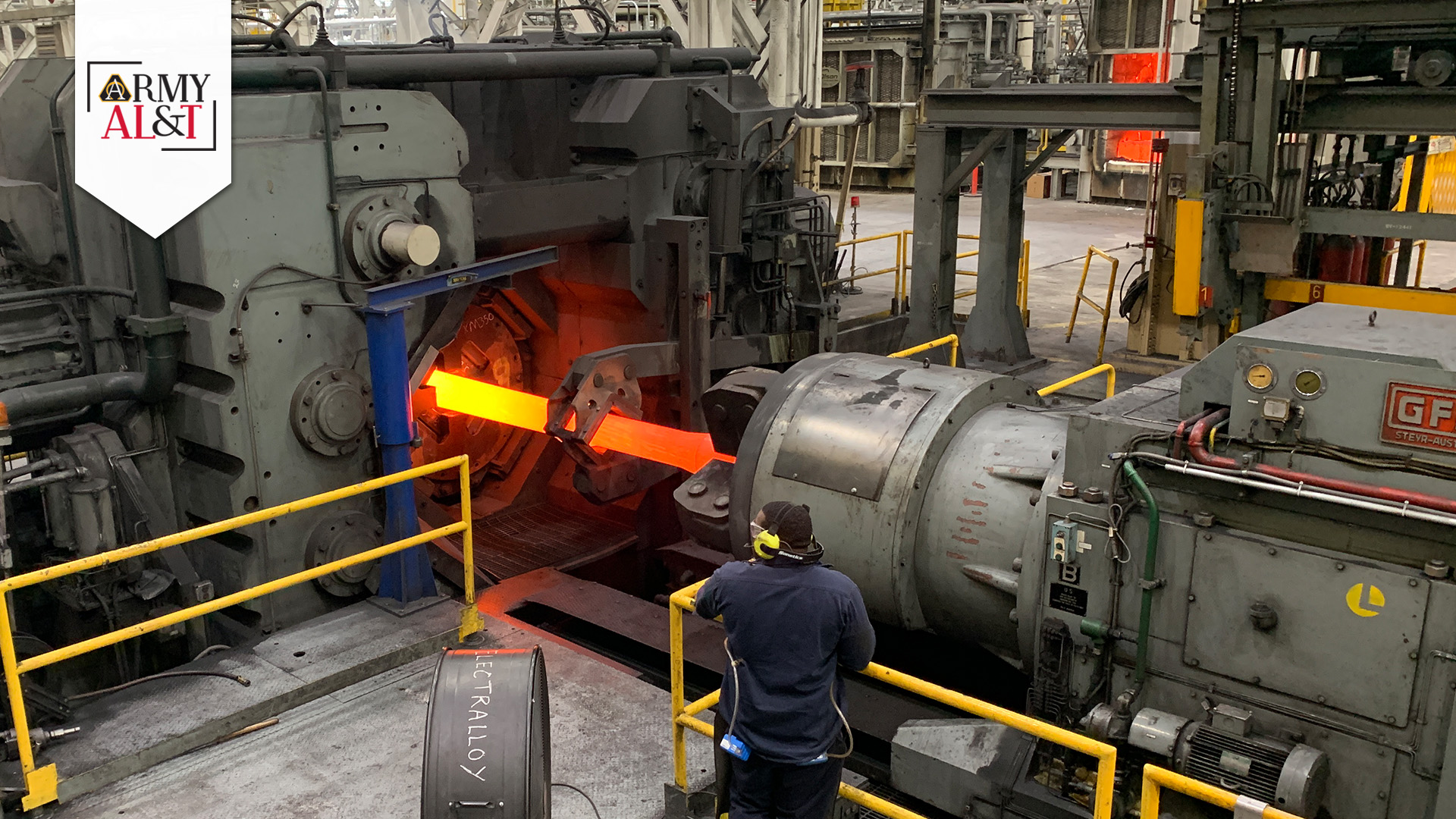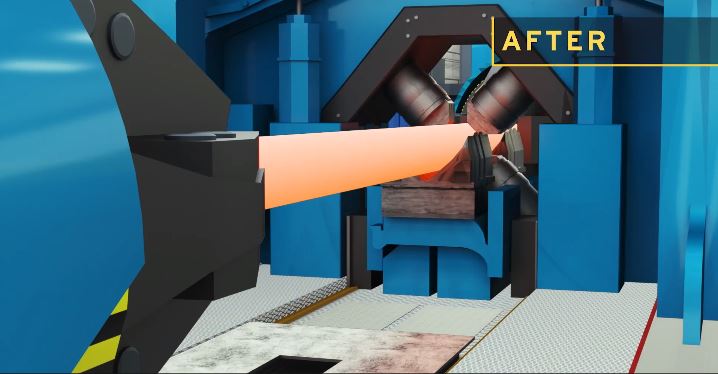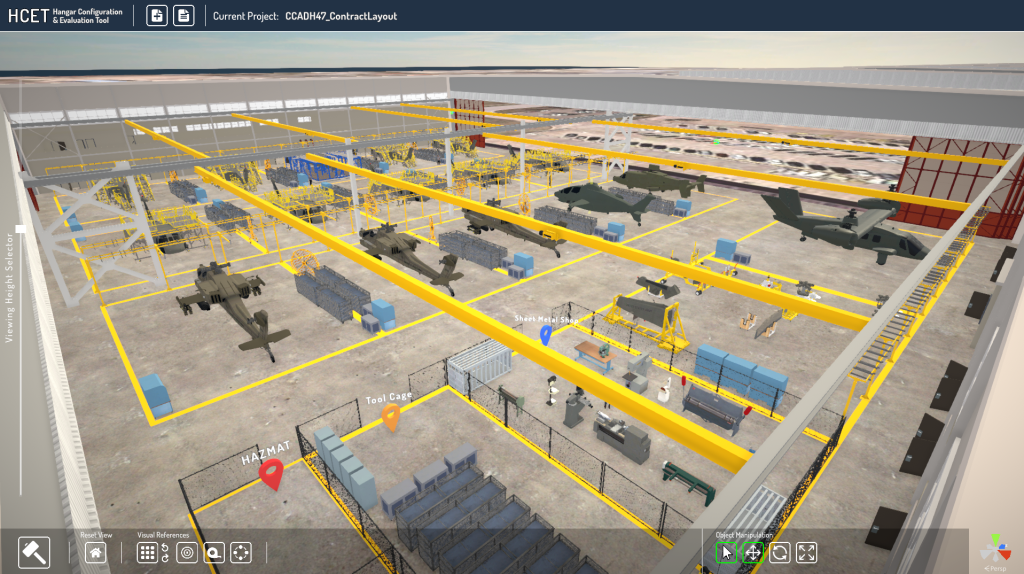
THE FORGE: BEFORE At Watervliet Arsenal, New York, a cannon tube is being processed through the current rotary forge. Watervliet Arsenal plans to replace the forge with a new, more capable forge in fiscal year 2026 as a part of the Army’s 15-year OIB Modernization Implementation Plan. (Photo by Matthew Day, U.S. Army Watervliet Arsenal Public Affairs)
AMC is modernizing facilities, processes and the artisan workforce to ensure the Army’s organic industrial base can meet the needs of the future force in a multidomain operations environment.
by Rich Martin
“The [organic industrial base] OIB is our nation’s national insurance policy, ready whenever we need it, and for more than a year it has been demonstrating its importance to the world.”
— Gen. Charles Hamilton, commander of the Army Materiel Command (Redstone Arsenal, Alabama, June 2023)
The Army’s OIB comprises 23 arsenals, depots and ammunition plants that manufacture, reset and maintain Army equipment providing critical support and sustainment to our warfighters. Like an insurance policy, the OIB must be ready whenever the nation needs it. To ensure readiness, the Army is investing to meet the needs of the future force in a multidomain operations environment. The time to modernize is now, or we risk being late when called upon.
The Army, through Army Materiel Command (AMC), has embarked on a 15-year OIB Modernization Implementation Plan that will modernize facilities, processes and the artisan workforce bringing in industry best practices, improving the human resource management structure and placing an emphasis on workforce skills and capabilities.
EFFORTS UNDERWAY
Over the past two years, AMC’s OIB modernization task force worked extensively with the Assistant Secretary of the Army for Acquisitions, Logistics and Technology (ASA(ALT)), and alongside industry and academia, to develop and refine the OIB modernization plan focusing investments on the most critical areas that will yield the right effects to ensure our facilities and workforce are ready to meet the needs of the joint force. The plan looks holistically across the OIB to incorporate emerging technologies into our facilities from industrial operations to installation and cybersecurity, energy and power resilience, and more.
The end state is to sustain the artisan workforce, maintain pace with the Army’s modernization of weapon systems and enable surge capacity for large scale combat operations. The decisions we make today are setting the course for the OIB over the next 40 to 50 years in support of the Army’s modernization efforts. Examples include modernizing the powertrain facility at Corpus Christi Army Depot, Texas to provide enduring platforms enabling support for Future Vertical Lift; ammunition plant production lines must now be prepared to produce the right size and scale of ammunition for the Next Generation Squad Weapon; and we are upgrading products at Redstone River Army Depot, Texas to improve efficiency and reduce supply chain risks.
As Hamilton also said, these modernization efforts are about taking the phrase “factory to foxhole” and flipping it to “foxhole to factory.” This will allow the OIB to provide precision sustainment and predictive logistics through data and information system technology, meaning that what happens on the battlefield can inform the factory and decisions made. So as rounds of ammunition are fired or repair parts are called for, the Army’s arsenals, depots and ammunition plants will already be working on what the Soldier needs.
Modernization in the OIB will be executed without sacrificing readiness. In fact, modernization is already underway, the OIB showcased its’ criticality in sustaining operations in Eastern Europe, accelerating modernization efforts ahead of the OIB modernization plan’s original fiscal year 2024 start date.

THE FORGE: AFTER: A rendering of the future rotary forge at Watervliet Arsenal, New York, that will increase capacity and quality, and support the trend toward developing longer, more capable artillery and cannons in support of the Army’s Long Range Precision Fires signature modernization efforts. (Image courtesy of Army Materiel Command)
THE MODERNIZATION GAME PLAN
Over fiscal year 2023, the Army is investing more than $2.6 billion in OIB modernization. In addition, DOD increased its investment in the Army’s OIB in the latest Program Decision Memorandum in fiscal year 2024 to 2028. This additional funding will help projects originally planned with a later start shift left, thus accelerating OIB Modernization Implementation Plan objectives by roughly four years. The plan looks across the OIB and synchronizes a cost-neutral investment of an estimated $18.1 billion in three phases: Build 21st Century Capability for the Future (fiscal years 2024-28), such as integrating microelectronics process at Tobyhanna Army Depot, Pennsylvania; Continue to Build Capabilities and Attack Vulnerabilities (fiscal years 2029-33), like modernizing pyrotechnic production at Crane Army Ammunition Activity, Indiana; and Maintain and Sustain OIB Investments (fiscal years 2034-38), which includes enabling energy resilience with accredited micro-grids at Tooele Army Depot, Utah.
To operationalize the plan, AMC and ASA(ALT) conduct bi-annual OIB modernization wargames where stakeholders meet to synchronize and prioritize resources, looking at each of the prioritized efforts to evaluate what will be needed in terms of workforce, information technology and cyber, and energy consumption requirements, using the data driving decision making tool, Vulcan.
Vulcan is a suite of tools that helps DOD adopt DevSecOps and Agile practices through project management, software development and IT infrastructure. New features and functionality are added routinely based on mission and need.
As the authoritative repository for Army OIB modernization requirements and prioritization, Vulcan contains over 2,000 projects spanning 15 years and is critical as it provides the ability to see potential impacts on projects such as increase in material costs, project priority changes, global events and supply chain issues.

WAR GAME PLANNING: A hangar configuration and evaluation tool is demonstrated at the Organic Industrial Base Modernization War Game held at Redstone Arsenal, Alabama, in the Aviation and Missile Command headquarters, June 13-15, 2023. Similar to a simulation video game, the tool allows users to place aircraft, electrical drops, toolboxes, and even personnel on the hangar floor to ensure adequate spacing and requirements needed to accommodate the enduring fleet, as well as future aviation assets. (Photo by Michelle Gordon, U.S. Army Aviation and Missile Command)
CONCLUSION
Readiness starts at home. The Army is investing in the OIB to sustain critical support to the future joint force and advancing its means and capabilities to harden and protect key assets from threats across any domain, including cyber. The OIB Modernization Implementation Plan includes requirements for cybersecurity and cyber protection, utilities, production and manufacturing methods, as well as energy improvements, environmental policy compliance and life, health and safety of the workforce.
For more information, go to https://www.amc.army.mil.
COL. (RET.) RICH MARTIN serves as the director of the AMC Organic Industrial Base Modernization Task Force, charged with developing the Modernization Implementation Plan which will synchronize AMC’s strategic investments in the depots, arsenals and ammunition plants of the OIB over the next 15 years. Martin holds an M.A. in business and organizational security studies from Webster University; two Masters of Military Arts and Sciences from the School of Advanced Military Studies; and a B.A. in sociology from the University of North Carolina at Chapel Hill.


